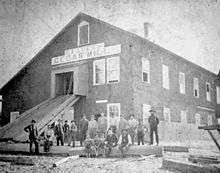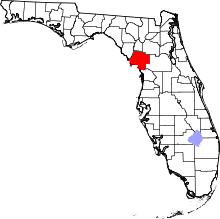Rosewood, Florida
Rosewood is a former populated place in Levy County, Florida, United States. The site is located just off State Road 24, approximately 1 mile (1.6 km) northeast of Sumner and 9 miles (14 km) northeast of Cedar Key.[1] The town was destroyed by whites and subsequently abandoned in 1923 as a result of a white woman claiming that a black man had raped her, leading to the Rosewood massacre.
History

Rosewood was settled in 1845, nine miles (14 km) east of Cedar Key, near the Gulf of Mexico. Local industry centered on timber. The name Rosewood refers to the reddish color of cut cedar wood. Two pencil mills were nearby in Cedar Key; several turpentine mills and a sawmill three miles (4.8 km) away in Sumner helped support local residents, as did farming of citrus and cotton. The hamlet grew enough to warrant the construction of a post office and train depot on the Florida Railroad in 1870, but it was never incorporated as a town.
The initial settlers of Rosewood were both black and white. When most of the cedar trees in the area had been cut by 1890, the pencil mills closed, and many white residents moved to Sumner. By 1900, the population in Rosewood had become predominantly black. The village of Sumner was predominantly white, and relations between the two communities were relatively amicable.[2] The population of Rosewood peaked in 1915 at 355 people. Two black families in Rosewood named Goins and Carrier were the most influential. The Goins family brought the turpentine industry to the area, and in the years preceding the attacks, were the second largest landowners in Levy County.[3] To avoid lawsuits from white competitors, the Goins brothers moved to Gainesville, and the population of Rosewood decreased slightly. The Carriers were also a large family, responsible for logging in the region. By the 1920s, almost everyone in the close-knit community was distantly related to each other.[4] Although residents of Rosewood probably did not vote because voter registration requirements in Florida had effectively disfranchised blacks since the turn of the century, both Sumner and Rosewood were part of a single voting precinct counted by the U.S. Census. In 1920, the combined population of both towns was 344 blacks and 294 whites.[5]
As was common in the late 19th century South, Florida had imposed legal racial segregation under Jim Crow laws, requiring separate black and white public facilities and transportation.[6] Blacks and whites created their own community centers: in 1920, the residents of Rosewood were mostly self-sufficient. They had three churches, a school, a large Masonic Hall, a turpentine mill, a sugarcane mill, a baseball team named the Rosewood Stars, and two general stores, one of which was white-owned. The village had about a dozen two-story wooden plank homes, other small two-room houses, and several small unoccupied plank farm and storage structures. Some families owned pianos, organs, and other symbols of middle-class prosperity. Survivors of Rosewood remember it as a happy place. In 1995 survivor Robie Mortin recalled at age 79, "Rosewood was a town where everyone's house was painted. There were roses everywhere you walked. Lovely."[7]
In January 1923, white men from nearby towns lynched a Rosewood resident allegedly in response to a lie that a white woman in nearby Sumner had been beaten and possibly raped by a black drifter. The woman was actually beaten up by her lover while her husband was at work. When black citizens defended themselves against further attack, several hundred whites organized to comb the countryside hunting for black people and burned almost every structure in Rosewood. Survivors hid for several days in nearby swamps and were evacuated by train and car to larger towns. Although state and local authorities were aware of the violence, they made no arrests for the activities in Rosewood. The town was abandoned by black residents during the attacks. None ever returned. In the spring of 1994, the Florida state legislature voted to give $2 million in compensation for the surviving families. In December 2010, a state scholarship was established for descendants of families that survived the massacre.[8]
References
- ↑ Rosewood on Google Maps
- ↑ Colburn, David R. (Fall 1997) "Rosewood and America in the Early Twentieth Century", The Florida Historical Quarterly, 76 (2), pp. 175–192.
- ↑ Jones, et al. "Appendices", p. 135.
- ↑ Jones, et al. "Appendices", p. 163.
- ↑ Jones et al., p. 20.
- ↑ Pildes, Richard H. "Democracy, Anti-Democracy, and the Canon", Constitutional Commentary (2000), 17, p 12–13.
- ↑ Jerome, Richard (January 16, 1995). "A Measure of Justice", People, 43 (2), pp. 46–49
- ↑ http://www.floridastudentfinancialaid.org/SSFAD/factsheets/Rosewood.htm
Further reading
- D'Orso, Michael (1996). Like Judgment Day: The Ruin and Redemption of a Town Called Rosewood. New York: G. P. Putnam's Sons. ISBN 0-399-14147-2.
External links
- Rosewood - Ghost Town
- Virtual Rosewood Research Site
- Song about the massacre written by Fire Next Time-https://www.youtube.com/watch?v=tDh8_fI0Bdk
Coordinates: 29°14′N 82°56′W / 29.233°N 82.933°W
